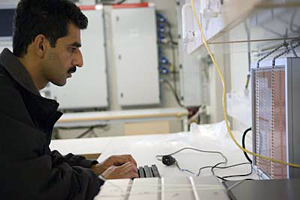|
Interview with Hanumant Singh - Part 1 by Lonny Lippsett, photo by Chris Linder
So what kind of adjustments do you have to make for the Arctic Ocean? So our operational scenario says that once a vehicle has completed its mission, it will rise to about 200 meters from the surface. We will communicate with it by transmitting and receiving acoustic signals. We’ll make another hole in the ice, tell the vehicle where that new hole is, and tell it to swim to the new hole for recovery. In a worst-case scenario—for example, we can’t talk to the vehicle, or it dies, or something bad happens to it—it’ll still float up toward the surface and, we should be able to locate where it is under the ice and make a hole and try to pull it out that way. What will the underwater vehicles look for? These vehicles have never been used before—are you optimistic? So, yes, it’s very risky. Yes, we have a strong chance of failure, where failure may be defined as losing a couple of vehicles and not getting enough data. But I believe we have a strong chance of success in terms of actually going out and learning something about these hydrothermal vents, and maybe sampling some of them. Given the risks and the potential returns, we felt that this is worth pursuing, and that’s what we’re doing. You know, even in open water it often it takes people months to find vent sites. Trying to do this under ice in the Arctic is way, way harder. So stay tuned. (continued) Page [ 1 ] [ 2 ]
|
Mailing List | Feedback | Glossary | For Teachers | About Us | Contact
© 2010 Dive and Discover™. Dive and Discover™ is a registered trademark of Woods
Hole Oceanographic Institution

 How does ice make your life more difficult?
How does ice make your life more difficult?